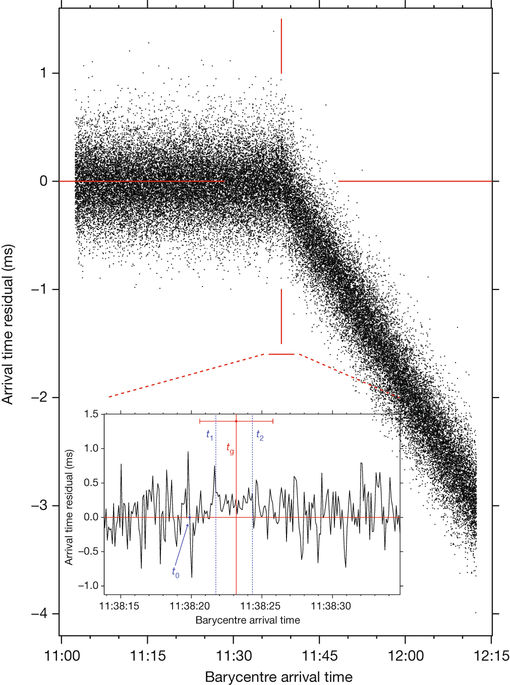Our official English website, www.x-mol.net, welcomes your
feedback! (Note: you will need to create a separate account there.)
Alteration of the magnetosphere of the Vela pulsar during a glitch
Nature ( IF 50.5 ) Pub Date : 2018-04-01 , DOI: 10.1038/s41586-018-0001-x Jim Palfreyman , John M. Dickey , Aidan Hotan , Simon Ellingsen , Willem van Straten
Nature ( IF 50.5 ) Pub Date : 2018-04-01 , DOI: 10.1038/s41586-018-0001-x Jim Palfreyman , John M. Dickey , Aidan Hotan , Simon Ellingsen , Willem van Straten

|
As pulsars lose energy, primarily in the form of magnetic dipole radiation, their rotation slows down accordingly. For some pulsars, this spin-down is interrupted by occasional abrupt spin-up events known as glitches1. A glitch is hypothesized to be a catastrophic release of pinned vorticity2 that provides an exchange of angular momentum between the superfluid outer core and the crust. This is manifested by a minute alteration in the rotation rate of the neutron star and its co-rotating magnetosphere, which is revealed by an abrupt change in the timing of observed radio pulses. Measurement of the flux density, polarization and single-pulse arrival times of the glitch with high time resolution may reveal the equation of state of the crustal superfluid, its drag-to-lift ratio and the parameters that describe its friction with the crust3. This has not hitherto been possible because glitch events happen unpredictably. Here we report single-pulse radio observations of a glitch in the Vela pulsar, which has a rotation frequency of 11.2 hertz. The glitch was detected on 2016 December 12 at 11:36 universal time, during continuous observations of the pulsar over a period of three years. We detected sudden changes in the pulse shape coincident with the glitch event: one pulse was unusually broad, the next pulse was missing (a ‘null’) and the following two pulses had unexpectedly low linear polarization. This sequence was followed by a 2.6-second interval during which pulses arrived later than usual, indicating that the glitch affects the magnetosphere.Single-pulse radio observations of a glitch in the Vela pulsar show sudden changes in the pulse shape coincident with the glitch, indicating that the glitch could affect the pulsar’s magnetosphere.
中文翻译:

故障期间船帆座脉冲星磁层的变化
随着脉冲星主要以磁偶极子辐射的形式损失能量,它们的自转也会相应减慢。对于某些脉冲星,这种自旋下降会被称为故障1的偶尔突然的自旋上升事件中断。假设故障是钉扎涡度的灾难性释放,它提供了超流体外核和地壳之间角动量的交换。这表现为中子星的旋转速率及其同向旋转的磁层发生了微小的变化,这可以通过观测到的无线电脉冲时间的突然变化来揭示。以高时间分辨率测量毛刺的通量密度、极化和单脉冲到达时间,可以揭示地壳超流体的状态方程、其拖升比和描述其与地壳摩擦的参数。迄今为止,这是不可能的,因为故障事件的发生是不可预测的。在这里,我们报告了 Vela 脉冲星中一个小故障的单脉冲无线电观测,它的旋转频率为 11.2 赫兹。该故障是在 2016 年 12 月 12 日世界标准时间 11 点 36 分在连续三年对脉冲星的观测期间检测到的。我们检测到与毛刺事件同时发生的脉冲形状突然变化:一个脉冲异常宽,下一个脉冲丢失(“空”),接下来的两个脉冲具有出乎意料的低线性极化。此序列之后是 2.6 秒的间隔,在此期间脉冲到达的时间比平时晚,表明故障影响了磁层。对船帆座脉冲星故障的单脉冲无线电观测显示,脉冲形状与故障同时发生突然变化,
更新日期:2018-04-01
中文翻译:

故障期间船帆座脉冲星磁层的变化
随着脉冲星主要以磁偶极子辐射的形式损失能量,它们的自转也会相应减慢。对于某些脉冲星,这种自旋下降会被称为故障1的偶尔突然的自旋上升事件中断。假设故障是钉扎涡度的灾难性释放,它提供了超流体外核和地壳之间角动量的交换。这表现为中子星的旋转速率及其同向旋转的磁层发生了微小的变化,这可以通过观测到的无线电脉冲时间的突然变化来揭示。以高时间分辨率测量毛刺的通量密度、极化和单脉冲到达时间,可以揭示地壳超流体的状态方程、其拖升比和描述其与地壳摩擦的参数。迄今为止,这是不可能的,因为故障事件的发生是不可预测的。在这里,我们报告了 Vela 脉冲星中一个小故障的单脉冲无线电观测,它的旋转频率为 11.2 赫兹。该故障是在 2016 年 12 月 12 日世界标准时间 11 点 36 分在连续三年对脉冲星的观测期间检测到的。我们检测到与毛刺事件同时发生的脉冲形状突然变化:一个脉冲异常宽,下一个脉冲丢失(“空”),接下来的两个脉冲具有出乎意料的低线性极化。此序列之后是 2.6 秒的间隔,在此期间脉冲到达的时间比平时晚,表明故障影响了磁层。对船帆座脉冲星故障的单脉冲无线电观测显示,脉冲形状与故障同时发生突然变化,











































 京公网安备 11010802027423号
京公网安备 11010802027423号